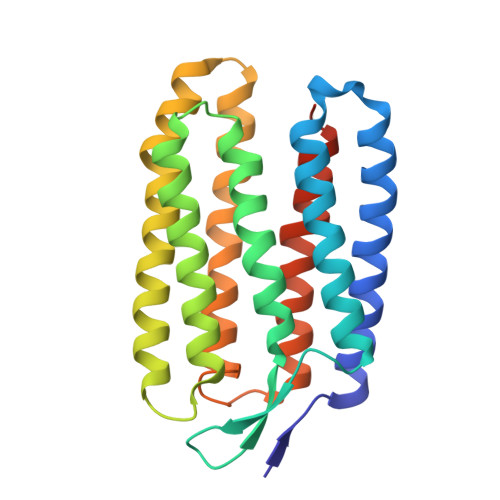Design of a light-gated proton channel based on the crystal structure ofCoccomyxarhodopsin.
Fudim, R., Szczepek, M., Vierock, J., Vogt, A., Schmidt, A., Kleinau, G., Fischer, P., Bartl, F., Scheerer, P., Hegemann, P.(2019) Sci Signal 12
- PubMed: 30890657
- DOI: https://doi.org/10.1126/scisignal.aav4203
- Primary Citation of Related Structures:
6GYH - PubMed Abstract:
The light-driven proton pump Coccomyxa subellipsoidea rhodopsin (CsR) provides-because of its high expression in heterologous host cells-an opportunity to study active proton transport under controlled electrochemical conditions. In this study, solving crystal structure of CsR at 2.0-Å resolution enabled us to identify distinct features of the membrane protein that determine ion transport directivity and voltage sensitivity. A specific hydrogen bond between the highly conserved Arg 83 and the nearby nonconserved tyrosine (Tyr 14 ) guided our structure-based transformation of CsR into an operational light-gated proton channel (CySeR) that could potentially be used in optogenetic assays. Time-resolved electrophysiological and spectroscopic measurements distinguished pump currents from channel currents in a single protein and emphasized the necessity of Arg 83 mobility in CsR as a dynamic extracellular barrier to prevent passive conductance. Our findings reveal that molecular constraints that distinguish pump from channel currents are structurally more confined than was generally expected. This knowledge might enable the structure-based design of novel optogenetic tools, which derive from microbial pumps and are therefore ion specific.
Organizational Affiliation:
Experimental Biophysics, Institute for Biology, Humboldt-Universität zu Berlin, Invalidenstr. 42, 10115 Berlin, Germany.

















